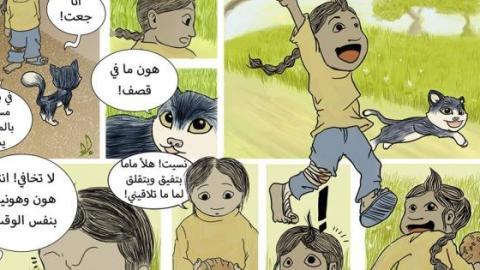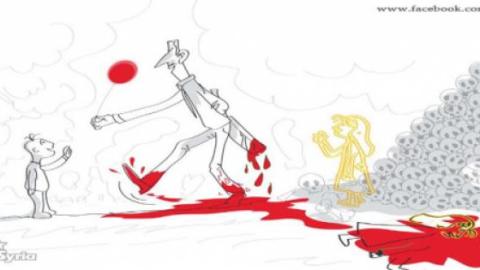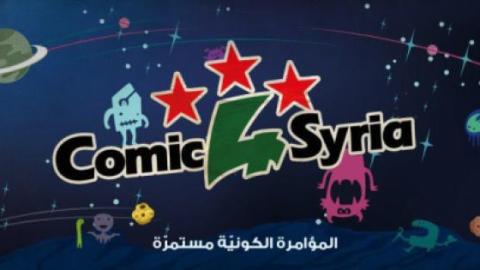Comic strips are one of various types of art in the arsenal of the Syrian revolution. The country has always had a strong tradition of highly metaphorical editorial cartoons in its heavily censored press. Recently, a new generation of illustrators, graphic designers, and animators - some with backgrounds in fine arts or advertising - have been anonymously posting their responses to Syria’s turmoil on a Facebook page called Comic4Syria. In the Arab world, comics have traditionally been directed at children, but these artists have made them relevant to adults, and have been successful enough to grab the attention of the international press.
Comic4Syria has transformed comics into a medium capable of “documenting some of the events that are taking place in the Syrian revolution, focusing on humanitarian and revolutionary issues being experiences by the people, and also shedding light on mistakes being made by rebels.”
The artists in the group turn minor incidents into visual stories, exposing the faults of both sides of the conflict. They use art to express themselves in their struggle against a dictator, while also trying to ensure they prevent a new dictatorship from arising.
The idea for Comic4Syria was developed by a group of friends who decided to write and draw comics, and share them on Facebook, “since we were fans of this form of art,” one of the founders said to Syria Untold. “Other artists and writers were eventually motivated to collaborate with us to produce different works of art,” he added.
Their art is inspired by actual events in the Syrian revolution. “We try not to be repetitive,” the artist said. “When we work on a comic, we try to focus on a single, important point that impacts a large number of Syrians experiencing the revolution and the war. We try to tackle many events, emotions, ideals and mistakes, and try to deliver our message in a clear and impactful manner.”
One issue that Comic4Syria has addressed is sectarianism. One of their comics mocked the joint effort by the Syrian and Iranian regimes to oppress the Syrian people, while another, titled “Mourning” described the suffering experienced by the families of soldiers who return home dead. “Military Honor” depicted the way Syrian soldiers guarded incarcerated civilians as Israeli warplanes bombed their country.
Other topics addressed in their comics include biased media reports, misguided statements made by members of the opposition, or signs held at protests. The Comic4Syria team has taken these ideas and transformed them into engaging and creative, but realistic, stories.
When asked about the process through which their drawings are born, one of the activists said, “We usually write the story, and then discuss it and make changes if necessary. Then, one of the artists takes the story and draws it. Sometimes, it is the artists who come up with the story themselves and draw it immediately, but usually we deliberate as a group first.”
Their work is not limited to comics; They also work caricature-like paintings.
The Comic4Syria volunteers hope to motivate “other artists and writers to join forces” with them. They also aim to remind people of the ideals and goals upon which the revolution was founded. “The free Syrian individual, who is aware and creative, and who wants to live in freedom and dignity, is the compass that guides us.”
Over the last year, the group has produced more than 100 pieces of art, and has developed a large audience. “It makes us happy when people debate our controversial artwork, especially when it focuses on mistakes in the revolution,” the artist said.
The team has its ups and downs, but has overall been pleased by the response it has gotten. “When the Guardian newspaper wrote about us, we felt like we were being recognized for our professional work,” he added, saying that positive comments left by fans on their Facebook page are also motivating.






